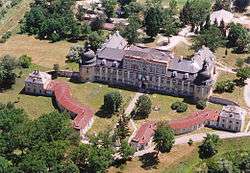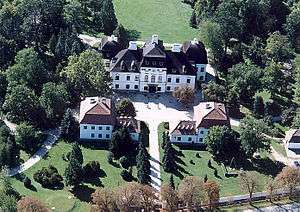Palaces and mansions in Hungary
There are more than 2000 castles and mansions today in Hungary, with about 700 of them under protection. Castle construction thrived during the politically tranquil 18th century,which became one of the most important periods of construction in the history of the cultural development of the country.
The style of these castles varies according to age and region, but invariably they show their uniquely Hungarian character. In spite of being modelled sometimes on foreign examples and built by foreign masters, they still bear the stamp of a style rooted in the Hungarian way of life.
18th century
Throughout the Middle Ages, while the country struggled to survive wars followed by 150 years of Turkish occupation, most of the existing castles were destroyed and very few of any note were built. Though the beginning of the period during which many of Hungary's castles were built was during the reign of Maria Theresa of Austria (ruled 1740 to 1780), the replacement of the destroyed or derelict castles and forts did not start in earnest before the end of the 18th century.
Besides the older Esterházy wealth, the riches of the Festetiches, Battyanyis, Pállfys, Károlyis, Erdődys and Rudnyánszkys grew during this period. Many aristocratic families used their wealth to develop their property through architecture. No longer desiring to live in the out-of-date forts built on top of hills, they chose the flat lands of their estates as locales for their splendid castles.
The nobility loved arts and sciences and lived within fine social norms; this had significant influence on the building of the castles. There are a lot of similar features in these buildings, which are now considered as Hungarian characteristics.
The picture of Hungarian castles would not be complete without mentioning the gardens arounds them. Since the era of Louis XIV (ruled 1643-1715), gardens were even more important than the buildings themselves. Hungarian nobles planned their gardens after the parks of French castles, the characteristics of which were orderliness, well arranged but with great variety.
The baroque garden strove for order and union. Because of the narrower financial possibilities, Hungarian baroque parks are much more modest than foreign ones, and as the art of garden-building is the most fleeting art, today we can hardly find anything of the old splendour of these parks.
19th century
The 19th century brought a new way of thinking. The English example can be felt in the social and political life of the country, and their influence is seen in the castles of the nobility as well. Above all, the taste of the 19th century changed the style of the gardens; the natural beauty of the trees and bushes were back in fashion. Botanical interest came into prominence; it was fashionable to collect special and rare plants. After the monopoly of the baroque, the gardens reflected the idea of "back to nature", which warmly surround our Greek-style pure castles.
Modern era
After the second World War the castles and their beautiful gardens became mainly state or co-operative property. Most of them functions today as museums, houses of culture, schools, sanatoriums or other public buildings.
Gallery
.jpg) Fáj - Fáy mansion
Fáj - Fáy mansion.jpg)
 Buda Castle - Royal Castle, Budapest
Buda Castle - Royal Castle, Budapest_6.jpg) Gödöllő - The Royal Palace
Gödöllő - The Royal Palace%2C_Visegr%C3%A1d.jpg) Visegrád - Royal Palace (14th century)
Visegrád - Royal Palace (14th century)- Tiszadob - Andrássy Mansion
.jpg) Fót - Károlyi Mansion
Fót - Károlyi Mansion_7.jpg) Fehérvárcsurgó - Károlyi Mansion
Fehérvárcsurgó - Károlyi Mansion Nagymágocs - Károlyi Mansion
Nagymágocs - Károlyi Mansion Füzérradvány - Károlyi Mansion
Füzérradvány - Károlyi Mansion_(5819._sz%C3%A1m%C3%BA_m%C5%B1eml%C3%A9k).jpg) Parádsavár - Károlyi Mansion
Parádsavár - Károlyi Mansion Sárospatak - Rákóczi Castle
Sárospatak - Rákóczi Castle- Nagycenk - Széchenyi Mansion
_3.jpg) Nádasdladány - Nádasdy Mansion
Nádasdladány - Nádasdy Mansion_2.jpg) Sárvár - Nádasdy Castle
Sárvár - Nádasdy Castle Hőgyész - Apponyi Mansion
Hőgyész - Apponyi Mansion- Seregélyes - Zichy Mansion
 Vaja - Vay Castle
Vaja - Vay Castle.jpg) Nagytétény - Száraz-Rudnyánszky Castle
Nagytétény - Száraz-Rudnyánszky Castle_6.jpg) Szabadkígyós - Wenckheim Mansion
Szabadkígyós - Wenckheim Mansion
 Noszvaj - De La Motte Mansion
Noszvaj - De La Motte Mansion_2.jpg) Mor - Lamberg Mansion
Mor - Lamberg Mansion_13.jpg) Tura - Schossberger Mansion
Tura - Schossberger Mansion Szentegát - Biedermann Palace
Szentegát - Biedermann Palaceparkja_(13234._sz%C3%A1m%C3%BA_m%C5%B1eml%C3%A9k)_5.jpg) Csalapuszta - Kégl Mansion
Csalapuszta - Kégl Mansion_4.jpg) Gyula Castle
Gyula Castle Kalocsa - Archbishop's Palace
Kalocsa - Archbishop's Palace Székesfehérvár - Bishop's Palace
Székesfehérvár - Bishop's Palace.jpg) Körmend - Batthyány Mansion
Körmend - Batthyány Mansion Szirak - Teleki-Degenfeld Mansion
Szirak - Teleki-Degenfeld Mansion Zsira - Rimanóczy-Pejachevich Castle
Zsira - Rimanóczy-Pejachevich Castle- Khuen-Héderváry Mansion
 Várpalota - Thury Mansion
Várpalota - Thury Mansion_2.jpg) Simonytornya Palace
Simonytornya Palace_5.jpg) Siklós - Garay Palace
Siklós - Garay Palace_2.jpg) Dég - Festetics Mansion
Dég - Festetics Mansion.jpg)

_2.jpg) Miskolc - Lilafüred Palace
Miskolc - Lilafüred Palace Széchény - Forgách Mansion
Széchény - Forgách Mansion%2C_Kossuth_Lajos_t%C3%A9r%2C_Hatvan3.jpg) Hatvan - Grassalkovich Mansion
Hatvan - Grassalkovich Mansion Ozora - Ozorai Pipo Mansion
Ozora - Ozorai Pipo Mansion
_10.jpg)

_2.jpg)
_32.jpg)